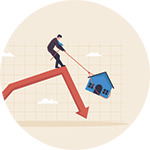How Will the Election Affect the Housing Market?
- February 2024 saw the worst-ever sales volume of 21,150, down 56% on February 2023.
- House prices are flat but close to record highs at £293,270; only 1% up on April 2023.
- Inflation falls to 2.8%, and the Base Rate stayed at 5.25% and is set to be reduced after the election in July.
- The General Election is impacting the housing market.
- Propertymark report "the number of market appraisals conducted per member branch increased from 22 in March 2024 to 26 in April 2024"
- Big banks drop mortgage rates ahead of election.
- Remortgages stall in anticipation of the fall in the BOE base rate.
With just days before the General Election, the housing market is sat biting its nails in hope or fear of what will happen on the 5th of July once the votes have been counted. In this report, I'll avoid any personal political opinion and focus on the one thing that matters - What will the successful party do to the housing market?
If we ignore the potential changing of the political guard, the signs are strong for the housing market.
- Inflation has fallen from 9.6% in October 2022 to 2.8% in June 2024.
- House price growth has slowed.
- Mortgage approvals for house purchases are 26% up at 61,140.
Rightmove reports that average asking prices remained near its record high in June, continuing the momentum seen in 2024 to date. The average house price across the UK in June is £375,110, a drop of just £21 following a record high in May 2024.
There are, however, the first signs of election caution with house buyers. The number of sales being agreed pre-election is stable, but not growing. This aligns with the normal trends during a general election, where sales volume falls for a few months before the election and then increase after. This general election appears to be following this same trend.
The Royal Institution of Chartered Surveyors (RICS) is echoing this as they see confidence in the housing market is starting to fall. There has been a ‘drop off’ in confidence among would-be buyers, affected by higher mortgage rates. As a result, estate agents are taking fewer inquiries, securing fewer sales and seeing more price reductions than in recent months.
It isn't just the election causing the buyers to take a step backwards; Crest Nicholson, the housing developer, states that house buyers are putting off purchasing a new home until the Bank of England cuts interest rates. This is now set for August, well after the result is announced.
According to Rightmove, May saw asking prices for homes hit a record-high. The average asking price of properties coming to the market was £375,131 in the four weeks to mid-May, up £2,807 on the previous month. Rightmove links the cause, as I've been reporting throughout my 2024 Housing Market Reports: pent-up buyer demand - a mini-bubble. The number of sales agreed during the first four months of the year was 17 per cent higher than for the same period last year.

What will the successful party do to the housing market?
My team has compiled the housing market pledges for the top 4 party's manifestos. Whoever gets in, I'll report back to these to see how they get on.
Conservatives Housing Manifesto
- Housebuilding: Deliver 1.6 million well-designed homes while protecting the countryside.
- Stamp Duty Threshold: Permanently increase the Stamp Duty threshold for first-time buyers to £425,000.
- Help to Buy Scheme: Launch a new Help to Buy scheme offering first-time buyers an equity loan of up to 20% for new-build homes, with a 5% deposit.
- Social Housing: Implement a 'three strikes and you’re out' policy for anti-social behaviour in social housing, expecting landlords to evict disruptive tenants.
- Renters Reform Bill: Pass a bill to ensure fairness in the rental market, abolish Section 21, and strengthen grounds for evicting tenants involved in anti-social behaviour.
- Leasehold Reform: Complete leasehold reforms to improve conditions for over four million leaseholders, capping ground rents at £250 and reducing them to peppercorn over time.
- Affordable Homes Programme: Renew the programme to deliver homes of all tenures and focus on regenerating housing estates.
- Brownfield Land Development: Build homes on brownfield land in urban areas, with a fast-track planning system for the 20 largest cities. Implement strong design codes for urban densification.
- Inner London Density: Raise housing density in inner London to levels seen in cities like Paris and Barcelona. Ensure the London Plan delivers more family homes and regenerates major sites like Euston, Old Oak Common, and Thamesmead.
- Urban Regeneration: Create locally-led urban development corporations to support new urban quarters in cities like Leeds, Liverpool, and York, and promote the Cambridge 2050 plan.
- Green Belt Protection: Maintain a commitment to protecting the Green Belt, ensuring new homes are built in sensible locations, primarily inner cities.
- Read the full Manifesto.
What do I think the housing market needs?
In my opinion, the housing market needs:
- Stability. BOE to maintain inflation at target levels, and the base rate will hover between 3.5-5%.
- Housing Supply. A continuous supply of new houses and incentives for homeowners to climb the ladder, to free up property for buyers.
- Affordable mortgage options. This is linked not only to lower mortgage rates but also to first-time buyer schemes such as mortgage guarantees for 5% deposits.
- Stamp Duty Relief. During Covid, the Tories implemented an SDLT holiday for all home buyers, which supported homeowners, landlords and first-time buyers. Keeping an active housing market at all levels is hugely important.
Will the winner finish off what has been started?
The Conservatives have put through several housing bills that need finishing off, which could be revised, delayed or scrapped by any new Party coming to power:
- Renters (Reform) Bill (Currently at 2nd reading in House of Lords)
- Domestic Energy (Value Added Tax) Bill (Currently at 1st reading in House of Commons
- Leasehold and Freehold Reform Act 2024 (This has passed Royal Assent)
- Landlord and Tenant Act 1985 (Amendment) Bill (Currently at 1st reading at House of Commons)
- Housing Act 1988 (Amendment) Bill [HL] (Currently at 1st reading in House of Commons)
- High Streets (Designation, Review and Improvement Plan) Bill (Currently at 2nd reading in House of Lords)
- High Speed Rail (Crewe - Manchester) Bill (Currently at 2nd reading in House of Commons)
- Green Belt (Protection) Bill (Currently at 1st reading in House of Commons)
For example, Labour have proposed changes to the Renters (Reform) Bill to ban no fault evictions and to prevent bidding wars. This includes requiring landlords and letting agents to state the amount of rent payable when advertising a property and preventing them from encouraging prospective tenants to offer to pay more than this. This illustrates how the parties' visions differ over the same bill; other bills could be amended by a new government, similarly.
What happened last time there was a General Election?
Conservative Victory
- Conservative with 317 seats (net change of -13)
- Labour with 262 seats (net change of +30)
- SNP with 35 seats (net change of -21)
- Lib Dem with 12 seats (net change of +4)
Collectively, Conservative and Labour won 82.3% of the UK vote.
Voter turnout was 68.8% (highest since 1997).
What impact did it have on the housing market?
|
Month
|
Price change YoY
|
Sales change YoY
|
| July 2017 | +4% | -1% |
| August 2017 | +5% | +4% |
| September 2017 | +5% | +3% |
Labour Victory
- Labour with 355 seats (net change of -47)
- Conservatives with 198 seats (net change of +33)
- Lib Dems with 62 seats (net change of +11)
Voter turnout was 61.4%.
What impact did it have on the housing market?
|
Month
|
Price change YoY
|
Sales change YoY
|
| June 2005 | +7% | -23% |
| July 2005 | +6% | -24% |
| August 2005 | +5% | -13% |
A data report commissioned by Winkworth, shows sales volume typically slows in the four months before an election, due to uncertainty. Buyers return to the market after the election, raising sales volume. This does not always drive up prices, suggesting elections are not the primary driver of house prices.
This is good news for the housing market whether or not we get a Tory, Labour or a coalition. The low sales volume through 15 months to February has already begun to recover. We can expect sales volume to increase from the 5th of July onward.

When will the base rate fall in 2024?
Inflation fell to the 2% target set by the Bank of England (BOE) for the first time since 2021. The ONS figures follow a sustained period of high inflation in the UK, which peaked at 11.1 per cent in October 2022, the highest level since 1981. This fall is met with confidence, but no knee-jerk changes to the BOE base rate, especially as we see wage growth at an all-time high.
In the June meeting of the Bank of England, the committee held interest rates at 5.25%. Andrew Bailey, the Governor of the BOE, welcomed the recent fall in inflation but said they “need to be sure that inflation will stay low” before cutting interest rates.
August is now the likeliest month for the potential cut to the Bank of England base rate, subject to the review of the incoming economic data between then and now. This removes any political spin doctors using the cut pre-election to their advantage.
New Build prices hit record high
The average price of a new build in England and Wales rose to £414,055 in April, up 14% on last year and setting a new record high. Buying a new build costs £121,000 more than an average-priced property.
Lowest sales volume for February
London 
London has the lowest sales volume for February, since records began; achieving just 2,007 sales, 60% down on the previous year's 4,960. Even after the financial crash of 2008, sales in December only fell to 4,505. For more on London, read: London Housing Market Report.
Average house prices in London fell year on year by 4%, to £501,880, for April 2024.
England & Wales
England and Wales echo London with a 56% fall year on year, making February the worst on record at 21,150 property sales. Sales volume will increase in the coming months as the activity for 2024 completes - there is normally a 3-6 month lead time from offer to completion.
Are UK house prices falling?
Average house prices in England & Wales rose year on year by 1% to £293,270 for April 2024. Savills predict house prices will rise a total of 21.6% nationally, from the beginning of 2024 to the end of 2028.
Big banks drop rates ahead of election
Some of the big high street banks have made a move before the election and the potential fall in interest rates. Barclays, HSBC and Natwest are leading the way in cutting mortgage rates on fixed-rate deals, with others expected to follow. An anticipated 1.6 million people are coming off lower, fixed-rate deals this year and will look for the market's best affordable rates.
If you are planning to remortgage, contact us as we have a panel mortgage broker who can help access the whole mortgage market. Book a free mortgage chat.
Mortgage approval reports
Home buyers
Mortgage approvals for home buyers grew in April to 61,140, up by 26% on last year. The market is growing in confidence and the properties being secured in 2024 will start showing in the sales volume once completions take place.
Remortgages
The remortgage growth was less confident than for home buyers, with a 10% YOY fall to 29,867 mortgage approvals. The general election and the potential benefits of an August fall in interest rates will slow down the number of remortgages as homeowners want to secure the best 2, 3 or 5-year fixed-rate deal.
Mortgage repayments cost more for first-time buyers in 2024
Rightmove reported that First-time buyers’ monthly mortgage repayments have increased by 61% over the past five years. A FTB would pay £667 in 2019 versus £1,075 a month in 2023.
Increases in mortgage interest rates have also meant a first-time buyer taking out a five-year fixed-rate mortgage, spread over 25 years and at an 80 per cent loan-to-value ratio, could previously have secured a mortgage rate of 2.24 per cent and is now likely to be at 5.09 per cent.
Mortgage arrears on the increase
The Bank of England reports that mortgage arrears have reached their highest level in more than seven years as higher interest rates impact household finances. The total value of mortgage balances with arrears increased by 44.5 per cent year-on-year to £21.3 billion in the three months to the end of March 2024.
The share of total loan balances with arrears, relative to outstanding mortgage balances, rose to 1.28 per cent, up from 1.23 per cent in the previous quarter. While this is increasing, the mortgage arrears are still low compared to the all-time high of 3.64 per cent in the first quarter of 2009, after the financial crash.
House building pledges, or big fat lies?
The Conservatives are pledging to build 320,000 new homes a year and Labour 300,000. It's not that I don't believe it can be achieved. It is the simple fact that in the last 46 years, we've not achieved anywhere near this, with the average for the last 5 years being 167,356 completed new builds; the average for the last 10 years is 156,692. Even during the boom years of 2005 to 2006 during the Labour Government, we averaged 207,355 for the 2 years before the financial crash.
The manifestos are promising what the housing market needs; but, it is far fetched at best, from any party.


Andrew Boast FMAAT
CEO of SAM Conveyancing
I am more than hopeful that we are seeing a strong housing market come to life. There is a delay in the sales being agreed upon and coming to completion in the Land Registry data.
The Bank of England is steering the economy well with a balanced and prudent approach to reducing the base rate and avoiding being embroiled in a very closely fought general election.
Activity with offers being agreed upon and remortgages are going to stall while we take a breath and watch the 4th of July play out. As long as the winning party continues to build, stabilise, and offer Stamp Duty initiatives and affordable housing, the housing market will react positively.
Sources: Latest data from - Gov.UK, Bank of England, UK House Price Index, ONS and Property Mark (NAEA).

Without Killing Anyone
This book could be the difference between every mover’s dream, buying and moving into your new home stress free, or, stress, missed deadlines, legal disasters, building defects, and possibly the collapse of the whole transaction. (Costing you a small fortune, a head full of grey hairs, and, driving you to threaten the life of your solicitor, lender, co-owners, family, partner, or some combination of all five).
With more than two decades’ experience in the conveyancing sector and over 50,000 successful client moves under his belt, Andrew shares insider tips and advice to empower you as a buyer, giving you the tools to make the best decisions for your circumstances and ease the chaos.
Available on Amazon | Kindle | Paperback












